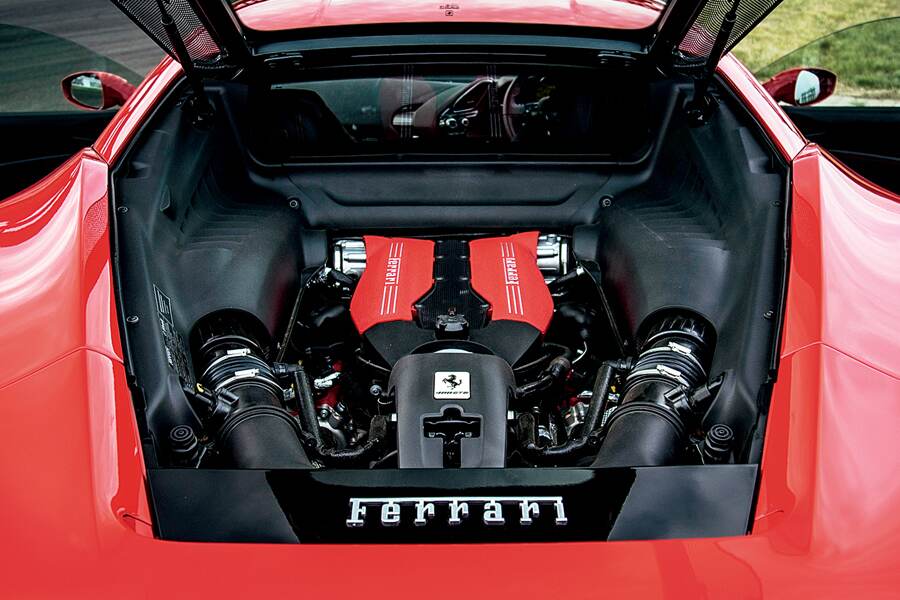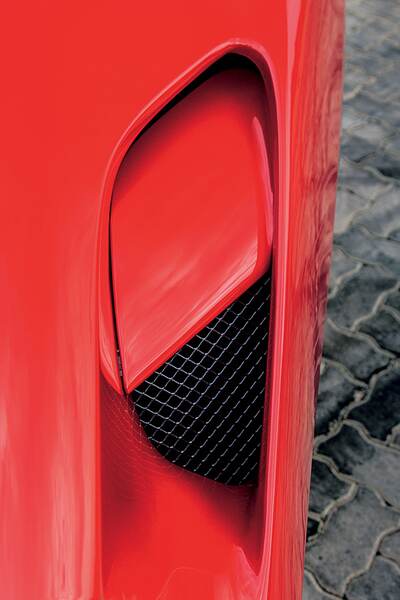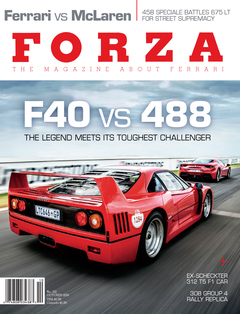It’s 04:30 a.m when we pull into the parking lot of official Ferrari dealer Scuderia South Africa Johannesburg, and even in the dark the profile of the waiting F40 is unmistakable. I first saw this Ferrari almost two years ago, and today, for the first time, I will be driving this legendary 1980s’ supercar.
Over the past 20 years, countless writers have evoked the F40’s pin-up status. It’s such a cliché, but it’s also true: I had two F40 posters in my room as a teenager. One was from a photo I took at a Ferrari meet at Brands Hatch in England in the early 2000s, the other was a regular commercial print that the car’s equally legendary designer, Leonardo Fioravanti, signed for me.
Anyway, back to the real-life car. This particular F40 (s/n 78673) is one of the first 50 units of 1,311 built, which means it wears the lightweight sliding side windows and forgoes adjustable suspension and a catalytic converter. The F40’s well-known 478-bhp power output was quoted for the later catalytic-equipped cars, and it’s rumored the non-cat models offer closer to 500 bhp. Whichever way you look at it, this is the F40 to have—and it’s not the only Ferrari I’ll be driving today.

Parked next to the Kevlar-bodied dream machine is an example of Ferrari’s newest regular-production mid-engine machine: the 488 GTB. In terms of design, the new model will never have the impact of the F40, simply because its overall design is so closely based on its predecessor, the achingly pretty 458 Italia. Nonetheless, even before the sun has risen, the 488 grabs my attention with its huge front air intake, the way the roof tapers towards the rear, and the side air intakes with their tiny dividers.
The question of the day is simple: Besides the conceptual similarities—two seats, mid-engine layout, twin-turbocharged V8 engine, scarcely believable performance for their respective eras—are there any real similarities between these two Ferraris? Much has transpired in the automotive world since the F40 went into production in 1987.
I’m no racing driver, but the obvious venue to sample each car is a racetrack. Thus, the morning’s first objective is to arrive at Red Star Raceway, 60 miles away, by sunrise. There’s no time to waste.

THE OWNER OF THE F40 opts to drive his car for the first part of the journey, while its fluids rise to their optimal operating temperatures. I climb into the passenger seat and pull the door shut by clumsily grasping its rudimentary plastic inner liner. There is no conventional inside handle, just a simple wire loop that releases the door latch.
The doors aren’t the only Spartan item found inside the cabin. The dash is covered in felt, and there’s glue sticking out of the joints in the carbon-fiber/Kevlar tub. It’s all a bit rough around the edges, but this was cutting-edge technology 30 years ago and Ferrari was one of the first manufacturers to use such weight-saving measures in a production car. In total, the bodywork consists of 11 carbon/Kevlar panels and, incredibly, they are (barely) covered in just a half-gallon of paint. The result is an impressive dry weight of only 2,434 pounds.
In the light early morning traffic, the F40 seems almost other-worldly. It may be nearly three decades old but, as it hugs the fast lane, the Ferrari must look immensely dramatic as the few highway lamps throw rays sporadically over the red body panels and that blockish rear wing. I wish I could be a pedestrian and view the F40 as it flew past…then again, I’d much rather be behind the steering wheel, and my time is almost here.

Red Star Raceway is a privately owned racetrack located northeast of Johannesburg. The circuit consists of tight corners, S-bends, and a couple of straights, while the run-off areas are covered in grass—not that I have any intention of traversing them today.
The owner hands me the F40’s key, which I insert into the ignition and twist; the Ferrari’s fuel and electrical systems come alive. I then press the starter button located to the right of the steering wheel and just below the ignition slot. The engine lights almost immediately, helped by a slight prod of the throttle pedal. At idle, there’s little drama from the engine and exhaust, but I fully expect that will soon change.
As you have probably read before, the F40’s seating position is far from ideal. Although the bucket seat keeps me firmly in place (three widths were available: small, medium, and large), the top of the steering wheel tilts away from me, which makes me feel like I’m about to drive a large truck rather one of the world’s most famous sports cars. At least my head resides further away from the roof when I’m sitting in the driver’s seat.

As I prepare to pull away, I’m shocked by how heavy the clutch pedal is; how did people race these cars for 12 or 24 hours? Likewise, selecting gears requires focus and a strong shove. It’s a solid-feeling gearbox, though, and there’s absolutely no doubt whether or not the next gear is ready. Shifting is more of an event, in the most satisfying way, than in almost any other Ferrari I’ve driven to date. It’s right up there with the F50’s action, but the latter’s shifter can be wielded with slightly less effort!
I slowly press the throttle, and quickly realize there’s hardly any power delivery below 3,000 rpm. From there to 4,000 rpm, however, the twin IHI turbochargers start to make their presence felt. By 5,000 rpm they are on the boil, and the tachometer needle swings all the way past 7,000 rpm much quicker than I expected. The turbos and their pressurized pipe whistle and chirp constantly behind my shoulders, easily overpowering the deep undertone from the exhaust.
Make sure the heavy steering wheel is pointing straight ahead, as the push from behind is so sudden and the Ferrari is so light. The wide 335/35ZR-17 rear tires are just about able to transfer the sonorous wave of power and torque down on the asphalt, but if I’m too aggressive with the throttle the rubber will easily brake traction, especially on corner exits.

I aim to keep the revs above 4,000 rpm at all times around the track, but it’s not easy. Each gear change needs time and planning, including a blip of the throttle before engaging a lower cog. The shift action and tight tarmac keep me busy, but every time a small straight presents itself I crack a smile as the F40’s torque viciously reels in the next corner.
The Ferrari’s brakes do a great job of scrubbing off speed. I’m a bit surprised by this, having read plenty about owner’s upgrading their car’s stoppers with F50-size hardware, but I’m not at all surprised by the firmness of the brake pedal, which takes even more effort to depress fully than the clutch.
The angle of the steering wheel takes some adjustment, but the steering brims with feedback, as well as some kickback, in the turns. Mechanical grip is high at both ends, the aforementioned looming power-on oversteer notwithstanding.

After my session, I park the F40 and ponder the driving experience. It’s hard work, both physically and mentally, but the rewards are commensurately higher. I certainly understand why the world is still obsessed with this car, which Autocar summed up nicely back in May 1988: “The [F40 is the] closest any production car maker has yet come to race car levels” and, “given the right conditions, there’s very little doubt it is the personification of (a) ‘sports car.’” No truer words have ever appeared in print.
GREAT THINGS HAVE ALSO BEEN WRITTEN about the 488 GTB, and simply inspecting the multi-function steering wheel reveals the full three decades of technical advancement between the two Ferraris. The 488’s sleek, leather-lined cabin is also about as far as you can get from the F40’s, and it instinctively feels like a comfortable place to cross continents.
I turn the key and press the starter button—an interesting connection between the two cars—on the steering wheel, and the engine immediately barks awake with a rough exhaust note. I pull the right-hand paddle to select first and head out onto the track. As I short-shift through the gears on my first lap, the experience is so quiet and casual it’s easy to forget I have 670 hp at my disposal—about 40 percent more power than the F40. But that extra power reveals itself the instant I turn the manettino to Race, pull the left lever to drop down to second gear, and plant my foot to the carpet.

Turbo lag? What turbo lag? The engine reacts to my throttle input with only the briefest of delays, then pushes me back in the seat as the tach needle sweeps swiftly past 7,000 rpm, mirrored by the LEDs illuminating across the top of the steering wheel. I pull the right paddle just before the engine hits the limiter and, without so much as a moment’s hesitation, the incredible surge continues.
While the 488 is clearly much faster than the 458 it evolved from (let alone the F40), I can’t help but miss that normally aspirated car’s haunting high-rpm wail. The turbocharged car offers some of the classic V8 song, especially at full tilt, but it lacks intensity.
The 488 arrives in the corners much faster than the F40, and happily its carbon-ceramic brakes are spot-on in every way, from their staggering stopping power to their pitch-perfect pedal feel. The modern Ferrari turns in crisply and effortlessly and sticks like glue, although, as is the case with most modern cars, the wheel offers little in terms of feedback, especially when compared with the communicative F40’s.

When I’m waved into the pits, I park the 488 GTB and scratch my head a little. The newcomer is shockingly easy to drive shockingly fast. Perhaps it feels that way in part because my first time behind the wheel came on a track, where I could really exploit the Ferrari’s capabilities, but it also stands to reason. After all, the 488 is one of Ferrari’s bread-and-butter models, and not all buyers in this segment want a hardcore supercar. To the contrary, the GTB ticks all the boxes of an extraordinarily fast daily driver.
These are two fantastic Ferraris, then, but they are simply worlds apart. To answer my initial question, there’s absolutely nothing that ties the F40 and 488 GTB together in terms of driving experience. They are different cars from different eras aimed at different audiences.
For my money, though, the F40 is the one to buy (if you can’t afford both). It lived up to every expectation I had—a truly astonishing feat for a car I’d been fantasizing about for three decades!—and delivered a driving experience I’ll remember for decades to come.











